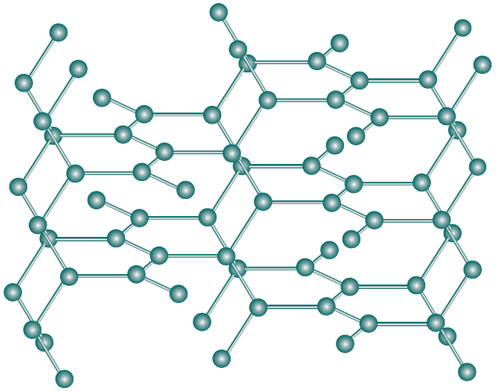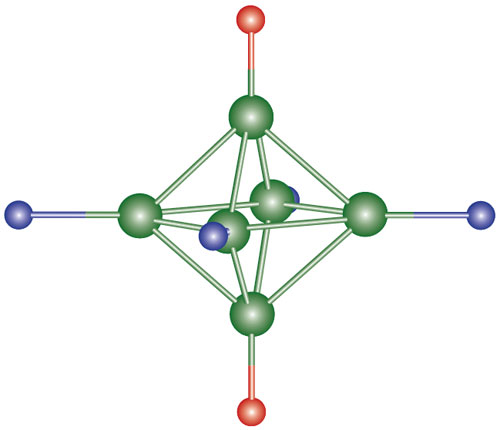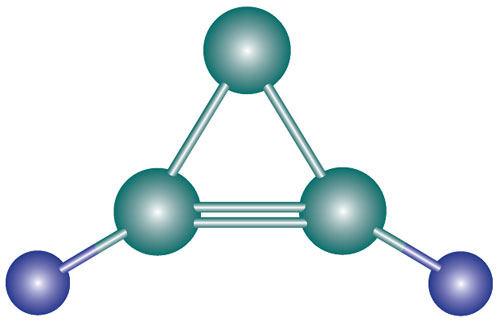Why Think Up New Molecules?
By Roald Hoffmann
Adding to the world of known chemical structures is a wonderful mental experiment
Adding to the world of known chemical structures is a wonderful mental experiment

DOI: 10.1511/2008.74.372
Some theoreticians in chemistry, myself included, like to think about molecules that do not (yet) exist. I use the simple word "think" purposely, for the design need not use fancy-schmancy, computer-intensive, "first-principles" calculations. We conjure up the chemical future in so many ways—through simple model building, qualitative thinking and ever-more-reliable quantum chemical calculations. Even in dreams, as Henning Hopf of the Technische Universität Braunschweig reminded me, referring to the German chemist Friedrich August Kekulé, who worked out the cyclic structure of the carbon-based molecule benzene in the mid-1800s. Kekulé stated that the structure came to him during a daytime reverie about the ouroboric symbol of a snake biting its own tail.

Stephanie Freese
But why do we try to imagine new molecules? Aren't there enough molecules already on Earth, be they natural or synthetic? A potpourri of reasons follows.
Synthesis, the making of molecules, is at the heart of chemistry—the art, craft, business and science of substances (molecules at the microscopic level) and their transformations. Of course you need to know what substances are, so analysis is a parallel, lively enterprise. As is figuring out why molecules have the colors or other properties they do, and why they react in certain ways and not others.
Chemists make the objects of their own contemplation. And, of course, study the beautiful, evolved world around and within them. By being as much (if not more) in the work of creation as discovery, chemistry is close to art. And lest we get too puffed up on that, creation also brings chemistry close to engineering (which certainly can have artistic elements in it).
I love explaining. But as a theoretician, I also want to take part in the work of creation. I can do so by thinking up interesting molecules not yet made. Maybe, just maybe, an experimentalist will try to make the molecule. Actually, given human nature, a hypothetical molecule will be made more expeditiously if it is thought up by the person who could synthesize it, rather than by me or some other theoretician.
Since chemistry is a semi-infinite macrocosm of structure, there are many interesting molecules waiting to be made. And still many more that might as well wait a while longer. Few of the 355 dodecanes (C12H26) are extant, for good reasons—new principles and properties are most unlikely to be found among them, because they're too similar to those that already exist.
So it's not just a matter of predicting any molecule that does not exist, it's predicting one that's in some way "interesting." That loose word has both cognitive and emotional sides to it, and is definitely subjective. Nevertheless, I find "interesting" works very well in evoking the psychological mix that makes the intelligent graduate student's mind hop to it. Some examples follow.
With Timothy R. Hughbanks of Texas A&M University, Miklos Kertesz of Georgetown (who were both at Cornell at the time) and Peter Bird of Concordia University in Montreal, we designed a carbon allotrope that, if it is made (no, when it is made!), will be metallic (see the first figure, in the opening paragraph). Now that would be interesting.

In another piece of work, Musiri M. Balakrishnarajan, in my group at the time and now at Pondicherry University in India, thought up a kind of three-dimensional analogue to one of the very best oxidation/reduction couples in organic chemistry, quinone/hydroquinone. Polyhedral boron cages, such as the octahedron shown in the second figure, can go through the process twice over, accepting two and four electrons (the intermediate stage of oxidation/reduction is shown) with correlated changes in geometry. The molecule will "breathe" as it sops up electrons.

To move away from my work, wonderful predictions were made of two variants of H2Si2, a simple molecule that is not likely to fill any glass bottles, but is nonetheless detectable. Wonderful, because they were completely unexpected—the molecule was calculated by Hans Lischka of the University of Vienna and Hans-Joachim Köhler of the Karl Marx University in Leipzig, not to have the expected acetylenic, or linear, H-Si-Si-H connectivity, but instead to feature two bridging hydrogens and a folded geometry. And it does! Then Brenda T. Colegrove and H. F. Schaefer III of the University of Georgia predicted a second "isomer" with a different shape to be metastable (see the third figure, at right). And this too was found, by Michel Cordonnier, Marcel Bogey, Claire Demuynck, and Jean-Luc Destombes of the Université des Sciences et Technologies de Lille in France, in 1992.
Compounds and molecules are often useful, ergo the vast transformative chemical industries (and the reasonably populated chemistry and chemical engineering departments of the world). Properties make for function. Be they materials for electronics, polymers with specific properties or pharmaceutical activity, adhesives working under extreme conditions—molecules perform tasks. But never as adequately and cheaply as we desire, of course. So there is a need for further design of molecules with specific properties.
Design is often a matter of tuning. Say one has a pharmaceutical lead, a compound with antitumor activity. The chances are that even as it works, the compound is toxic at some level, and that its biological efficacy can be improved. One wants to change a methyl group here for a fluorine, add two hydrogens there. This quantized perturbation of an underlying molecular skeleton is our métier, the craftsmanship as explicit in dye as drug design. But tuning is not random change. One needs a way to think about a property—the thinking need not be computational, it may be qualitative—before one sets to the work of synthesis. Here is a great place for theory.
Although modifying molecular bits here and there works, one lesson of chemistry has been that really new properties or functions come from big jumps, in structure and electronic properties. I'm thinking as much of liquid crystals and nylon as I am of fullerenes and metal-metal bonds. Here there is a still more significant role for theory. For small extrapolations are easy—you can calibrate your calculation; predicting the properties of a really different, unusual molecule is risky.
There are pitfalls, psychological ones, in the service of design. The designer's role is at times exaggerated in the process of seeking patronage, a forgivable sin. It is also what journalists think their audience wants to hear—fables of superminds whose predictions are always right. And people—scientists for sure—fall too easily into an excessive valuation of their own mastery of design, to burnish an impression of their rationality. An age-old problem for science, or rather for scientists….
Everything has antecedents and lush interconnections. Still, there is a real opportunity for theoretical chemistry in the creation of new classes of molecules. Instead of being servants to reductionism, we can signal emergence.
Theories are fecund webs of understanding. They come to be accepted by scientific communities for many reasons, but certainly the trait of making predictions, preferably risky ones, is an important factor in why people buy into theories.
Could one imagine a better probe of our comprehension of protein catalytic function than the design of an enzyme that, say, flips on its head the selectivity of a catalyzed reaction, or that turns over molecules faster than the natural one? If you have a theory of superconductivity, a super way to demonstrate your understanding would be not only to explain the observed isotope effects and the symmetry properties of the phenomenon, but also to predict what chemical compound should be a high-temperature superconductor. We're not there.
The consistent theoretical prediction of viable molecules with unusual structures or properties is the best test of the degree of understanding science has achieved.
The universe is teeming with extreme conditions, from the interior of a big planet to the cold and near-vacuum surrounding a grain in an interstellar cloud. In the course of a chemical reaction, a number of molecular "intermediates" may have only the most fleeting of existences. Their properties, their very existence, may simply not be measurable—out there, or in the confines of the laboratory.

Stephanie Freese
Here theoretical chemistry may really be of help. Quantum mechanics has already proved sufficiently reliable to calculate correctly the spectroscopic signatures of molecules in interstellar space. This is how a molecule relatively abundant out there, but hardly persistent in the laboratory, cyclopropenylidene, was detected (see the fourth figure, left).
So it is for the metastable intermediates of chemical reactions. There is every reason to think that calculations of their properties are as easy (or is it "as difficult"?) as the properties of stable molecules.
Theoreticians are a minority in chemistry, which remains an experimental science. Our experimental friends and that molecular cornucopia, the evolved biosphere, are so productive. We have been given and have made millions of molecules, with an incredible diversity in their properties. Some are just ringing changes on a theme, some pose real puzzles. So there we are, theoreticians, in a reactive mode, continually asked to explain.
I don't mind explaining. It is one good test of theory, for sure. But it is nice to turn the tables once in a while, and predict.
As it is, experimentalists and theorists have a certain love/hate relationship within any field, not just chemistry. The stereotypes are clear: To the experimentalist, theorists build castles in the air, don't deign to explain what bothers experimentalists, and simplify the world to the extent that it is rendered unreal (as with the "spherical cow" model). To the theorists, experimentalists complicate matters, vary too many factors simultaneously and never measure the observable that the theorists calculate.
It's a game; the "love" part is that both theory and experiment desperately need each other. For the facts are mute. And science, our way of knowing, depends on the coupling of imaginative flights of theoretical fancy with people probing down-to-earth physical and chemical reality.
So … it's fun to make moderately unreasonable predictions of viable or fleeting molecules. The operative part of the phrase is "moderately unreasonable." For if the prospect of synthesis is perceived as taking 20 man- or woman-years, the synthesis will not be attempted. Realistically, the quantum of commitment might be a single Ph.D. student's productive lifetime in graduate school.
Science is a marvelous quest for reliable knowledge. Knowing is a pleasure in and of itself. So is creation. As is sharing that knowledge, and yes, being thought of well for what one does.
The predictor leaves the safety of known molecules and properties for the unknown. He or she takes a risk. And, in a way, flirts—in a game of interest and synthesis—with the experimentalist. Predicting new molecules is simply great fun.
©Roald Hoffman
Click "American Scientist" to access home page
American Scientist Comments and Discussion
To discuss our articles or comment on them, please share them and tag American Scientist on social media platforms. Here are links to our profiles on Twitter, Facebook, and LinkedIn.
If we re-share your post, we will moderate comments/discussion following our comments policy.